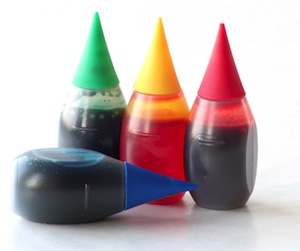Guest Writer for Wake Up World
Artificial additives pervade our food supply in epic proportions. Manufacturers claim the stuff is added to enhance flavor, appearance, texture, and shelf life.
Food dyes, a food additive used to deepen the color of candy, dry mixes, soups, and even bread, have gotten an increasing amount of criticism these last few years. Health authorities in Austria and Norway have even banned the use of artificial food dyes and European health authorities require a warning label on food that contains the synthetic ingredients. In Britain, warn labels caution that children who consume foods containing artificial food colorings are at greater risk for developing hyperactive behavior and ADHD.
Meanwhile, the FDA in the United States has little to say about the proven health dangers of these synthetic ingredients.
So just how dangerous are artificial food dyes? The next four facts will inform you.
4 Dangers of Common Food Dyes
1. Made From Petroleum
[pro_ad_display_adzone id=”110028″]
Originally made from coal tar, food dyes now come from an unrefined fuel source — petroleum. Consuming petroleum in any amount isn’t the most pleasant thought; however, that’s just what you may be doing if you eat non-organic, processed foods. Many popular sports drinks, sodas, powdered mixes, and energy drinks contain petroleum-derived food colorings.[1]
2. Possible Carcinogen
Red 40 and Yellow 5 and 6 contain the chemical benzene, a known carcinogen. The CDC claims that very little is known about the health effects of benzene, despite the mountain of evidence pointing at its cancer-causing potential.[2] While most of the world has banned the use of artificial additives containing this compound, American companies freely use Red 40 and Yellow 5 and 6 in many common processed food products. Processed macaroni and cheese, for example, commonly use Yellow 6 to bring out the food’s bright-yellow hue.
3. Contributes to ADHD Risk
Numerous studies have established a significant link between artificial food dyes and hyperactivity in children. An Australian study examining food dyes’ effects on 200 children found that 75% of parents noticed an improvement in behavior and attention once dyes were eliminated from their child’s diet.[3] Other research has validated this finding, suggesting future studies to determine safe intake levels for these products (if they exist, which I doubt).[4]
4. Estrogen Enhancers
Perhaps “enhance” isn’t the best word because this isn’t a good thing. Sunset yellow (Yellow 6) and tartrazine (Yellow 5) have been shown to behave like estrogen in the human body.[5] Why is this bad? Because high levels of estrogen, regardless of the source, can contribute to breast cancer and may decrease male sex drive, among other highly undesirable effects.[6][7]
Alternatives Exist – Choose Wisely!
The only way to completely avoid artificial food dyes is to consume an unprocessed, organic whole-food diet. If you’re in a time crunch and have to purchase a processed food item, make sure it is organic. Organic products are prohibited from using artificial coloring, sweeteners, or flavorings. Although processed organic foods are not the most nutrient-dense food on the planet, they are a far better alternative to other processed options.
Have you eliminated food dyes from your diet? What benefits have you experienced? Leave a comment and share your experience!
-Dr. Edward F. Group III, DC, ND, DACBN, DCBCN, DABFM
Article References:
- CSPI. Food Dyes: A Rainbow of Risks. Washington, DC: Center for Science in the Public Interest; 2010.
- Kobylewski S1, Jacobson MF. Toxicology of food dyes. Int J Occup Environ Health. 2012 Jul-Sep;18(3):220-46. doi: 10.1179/1077352512Z.00000000034.
- Rowe KS1, Rowe KJ. Synthetic food coloring and behavior: a dose response effect in a double-blind, placebo-controlled, repeated-measures study. J Pediatr. 1994 Nov;125(5 Pt 1):691-8.
- Stevens LJ1, Kuczek T, Burgess JR, Stochelski MA, Arnold LE, Galland L.Mechanisms of behavioral, atopic, and other reactions to artificial food colors in children. Nutr Rev. 2013 May;71(5):268-81. doi: 10.1111/nure.12023.
- Axon A1, May FE, Gaughan LE, Williams FM, Blain PG, Wright MC. Tartrazine and sunset yellow are xenoestrogens in a new screening assay to identify modulators of human oestrogen receptor transcriptional activity. Toxicology. 2012 Aug 16;298(1-3):40-51. doi: 10.1016/j.tox.2012.04.014.
- Russo J, Russo IH. The role of estrogen in the initiation of breast cancer. The Journal of Steroid Biochemistry and Molecular Biology. 2006 December;102(1-5):89-96.
- Siepmann T, Roofeh J, Kiefer FW, Edelson DG. Hypogonadism and erectile dysfunction associated with soy product consumption. Nutrition. 2011 July-August;27(7-8):859-62. doi: 10.1016/j.nut.2010.10.018.
Previous articles by Dr. Group:
- The Benefits of Organic Soap
- Ten Shocking Facts about Mercury Amalgam
- 10 Shocking Facts about the Health Dangers of Wi-Fi
- The 9 Best Herbs for Lung Cleansing and Respiratory Support
- 7 Best Foods to Support Kidney Function
- How to Flush the Liver
- Lung Cleansing With Peppermint Oil
- The Benefits of Organic Hemp Milk + How to Make Your Own
- What is Azodicarbonamide? 9 Facts About This Dangerous Food Additive
- 8 Must-Know Facts About Fukushima Nuclear Radiation
- Nine Shocking Dangers of Fluoride Exposure
- 10 Natural Remedies for Kidney Stones
- 12 Shocking Facts About the Dangers of Psychiatric Drugs
- Seven Facts You May Not Know About Coconut Oil
About the author:
 Dr. Edward F. Group (DC, ND, DACBN, DCBCN, DABFM) founded Global Healing Center in 1998 and is currently the Chief Executive Officer. Heading up the research and development team, Dr. Group assumes a hands-on approach in producing new and advanced degenerative disease products and information.
Dr. Edward F. Group (DC, ND, DACBN, DCBCN, DABFM) founded Global Healing Center in 1998 and is currently the Chief Executive Officer. Heading up the research and development team, Dr. Group assumes a hands-on approach in producing new and advanced degenerative disease products and information.
Dr. Group has studied natural healing methods for over 20 years and now teaches individuals and practitioners all around the world. He no longer sees patients but solely concentrates on spreading the word of health and wellness to the global community. Under his leadership, Global Healing Center, Inc. has earned recognition as one of the largest alternative, natural and organic health resources on the internet.
[pro_ad_display_adzone id=”110027″]







